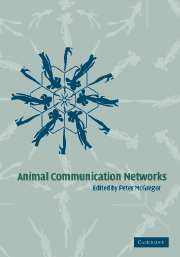Book contents
- Frontmatter
- Contents
- List of contributors
- Preface
- 1 Introduction
- Part I Behaviours specific to communication networks
- Part II The effects of particular contexts
- Part III Communication networks in different taxa
- Introduction
- 12 Waving in a crowd: fiddler crabs signal in networks
- 13 Anuran choruses as communication networks
- 14 Singing interactions in songbirds: implications for social relations and territorial settlement
- 15 Dawn chorus as an interactive communication network
- 16 Eavesdropping and scent over-marking
- 17 Vocal communication networks in large terrestrial mammals
- 18 Underwater acoustic communication networks in marine mammals
- 19 Looking for, looking at: social control, honest signals and intimate experience in human evolution and history
- Part IV Interfaces with other disciplines
- Index
14 - Singing interactions in songbirds: implications for social relations and territorial settlement
Published online by Cambridge University Press: 06 August 2010
- Frontmatter
- Contents
- List of contributors
- Preface
- 1 Introduction
- Part I Behaviours specific to communication networks
- Part II The effects of particular contexts
- Part III Communication networks in different taxa
- Introduction
- 12 Waving in a crowd: fiddler crabs signal in networks
- 13 Anuran choruses as communication networks
- 14 Singing interactions in songbirds: implications for social relations and territorial settlement
- 15 Dawn chorus as an interactive communication network
- 16 Eavesdropping and scent over-marking
- 17 Vocal communication networks in large terrestrial mammals
- 18 Underwater acoustic communication networks in marine mammals
- 19 Looking for, looking at: social control, honest signals and intimate experience in human evolution and history
- Part IV Interfaces with other disciplines
- Index
Summary
Introduction
Interactions between individuals make up a significant part of life in social animals. They form a crucial behavioural mechanism establishing and maintaining particular spacing patterns among individuals and groups of individuals and are inherent in the regulation of social relations. Animals interact with each other in a broad range of contexts, such as during intersexual competition, mate choice, or parent–offspring communication, but still many of the underlying principles share common ground (Hauser, 1996; Bradbury & Vehrencamp, 1998). It is well documented that the performance of individuals in interactions has profound implications for the resolution of conflicts over resources, such as mates, food or space. Interactions may consist of complex behavioural displays or may be based exclusively on signals in either one or several signalling modalities. Vocal interactions are among the most conspicuous forms of interactions and have been well studied in several taxonomic groups, such as insects, anurans and birds (Bradbury & Vehrencamp, 1998). In birds, vocal interactions are most evident in parent-offspring communication (Kilner & Johnstone, 1997; Ch. 9), calling and singing in group-living species (Farabaugh & Dooling, 1996; Zann, 1996), duetting in tropical songbirds (von Helversen, 1980; Farabaugh, 1982) and in singing interactions between male territorial songbirds (Todt & Naguib, 2000).
In this review, I will focus on singing interactions in male territorial songbirds. Their vocal interactions are among the most striking examples of bird vocal communication and are an established model for studies on territoriality and communication networks (McGregor, 1993; McGregor & Dabelsteen, 1996; Todt & Naguib, 2000).
- Type
- Chapter
- Information
- Animal Communication Networks , pp. 300 - 319Publisher: Cambridge University PressPrint publication year: 2005
- 30
- Cited by

